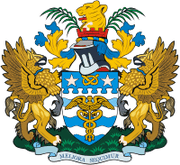City of Brisbane
| City of Brisbane Queensland | |||||||||||||
|---|---|---|---|---|---|---|---|---|---|---|---|---|---|
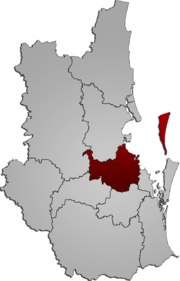 Map of Brisbane City in South East Queensland | |||||||||||||
 Flag of the City of Brisbane | |||||||||||||
| Coordinates | 27°28′S 153°07′E / 27.47°S 153.12°ECoordinates: 27°28′S 153°07′E / 27.47°S 153.12°E | ||||||||||||
| Population | 1,162,186 (2015)[1] | ||||||||||||
| • Density | 850.2/km2 (2,202/sq mi) | ||||||||||||
| Established | 1924 | ||||||||||||
| Area | 1,367 km2 (527.8 sq mi) | ||||||||||||
| Council seat | Brisbane CBD (City Hall) | ||||||||||||
| Region | South East Queensland | ||||||||||||
| State electorate(s) | Algester, Ashgrove, Aspley, Brisbane Central, Bulimba, Chatsworth, Clayfield, Everton, Ferny Grove, Greenslopes, Inala, Indooroopilly, Lytton, Mansfield, Moggill, Mount Coot-tha, Mount Ommaney, Nudgee, Sandgate, South Brisbane, Stafford, Stretton, Sunnybank, Yeerongpilly | ||||||||||||
| Federal Division(s) | Brisbane, Bonner, Griffith, Lilley, Moreton, Oxley, Petrie, Ryan | ||||||||||||
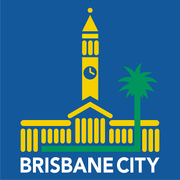 | |||||||||||||
| Website | City of Brisbane | ||||||||||||
| |||||||||||||
The City of Brisbane is the local government area that has jurisdiction over the inner portion of the metropolitan area of Brisbane, the capital of Queensland, Australia. Brisbane is located in the county of Stanley and is the largest city followed by Ipswich with bounds in part of the county. Unlike LGAs in the other mainland state capitals (Sydney, Melbourne, Perth and Adelaide), which are generally responsible only for the central business districts and inner neighbourhoods of those cities, the City of Brisbane administers a significant portion of the Brisbane metropolitan area, serving almost half of the population of the Brisbane Greater Capital City Statistical Area (GCCSA, formerly statistical division). As such, it has a larger population than any other local government area in Australia.[2] The City of Brisbane was the first Australian LGA to reach a population of more than one million.[3] Its population is roughly equivalent to the populations of Tasmania, the Australian Capital Territory and the Northern Territory combined. The Council administers a budget of over A$3 billion.[4]
The City derives from cities, towns and shires that merged in 1925. The main offices and Central Library of the Council are at 266 George Street, also known as Brisbane Square. Brisbane City Hall houses the Council Chamber, the offices of the Lord Mayor and Deputy Mayor, meeting and reception rooms and the Museum of Brisbane.
Wards
As of the election on 19 March 2016, the twenty-six wards, their councillors and their party affiliations were:[5]
| Party | Wards | Current Chamber (Total 26 Wards) | |
|---|---|---|---|
| Liberal National | 19 | | |
| Labor | 5 | | |
| Greens | 1 | | |
| Independent | 1 | | |
| Ward | Party | Councillor | |
|---|---|---|---|
| Bracken Ridge | LNP | Amanda Cooper | |
| Calamvale | LNP | Angela Owen-Taylor | |
| Central | LNP | Vicki Howard | |
| Chandler | LNP | Adrian Schrinner | |
| Coorparoo | LNP | Ian McKenzie | |
| Deagon | Labor | Jared Cassidy | |
| Doboy | LNP | Ryan Murphy | |
| Enoggera | LNP | Andrew Wines | |
| Forest Lake | Labor | Charles Strunk | |
| Hamilton | LNP | David McLachlan | |
| Holland Park | LNP | Krista Adams | |
| Jamboree | LNP | Matthew Bourke | |
| Macgregor | LNP | Steven Huang | |
| Marchant | LNP | Fiona King | |
| McDowall | LNP | Norm Wyndham | |
| Moorooka | Labor | Steve Griffiths | |
| Morningside | Labor | Shayne Sutton | |
| Northgate | LNP | Adam Allan | |
| Paddington | LNP | Peter Matic | |
| Pullenvale | LNP | Kate Richards | |
| Runcorn | LNP | Kim Marx | |
| Tennyson | Independent | Nicole Johnston | |
| The Gabba | GRN | Jonathan Sri | |
| The Gap | LNP | Steven Toomey[6] | |
| Walter Taylor | LNP | Julian Simmonds | |
| Wynnum Manly | Labor | Peter Cumming | |
Suburbs
The City of Brisbane includes the following settlements:
Inner suburbs
Total: 18
Northern suburbs
- Albion
- Alderley
- Ascot
- Aspley
- Bald Hills
- Banyo
- Boondall
- Bracken Ridge
- Bridgeman Downs
- Brighton
- Brisbane Airport
- Carseldine
- Chermside
- Chermside West
- Clayfield
- Deagon
- Eagle Farm
- Everton Park
- Fitzgibbon
- Gaythorne
- Geebung
- Gordon Park
- Grange
- Hamilton
- Hendra
- Kedron
- Keperra
- Lutwyche
- McDowall
- Mitchelton
- Myrtletown
- Newmarket
- Northgate
- Nudgee
- Nudgee Beach
- Nundah
- Pinkenba
- Sandgate
- Shorncliffe
- Stafford
- Stafford Heights
- Taigum
- Virginia
- Wavell Heights
- Wilston
- Windsor
- Wooloowin
- Zillmere
Total: 48
Southern suburbs
- Acacia Ridge
- Algester
- Annerley
- Archerfield
- Burbank
- Calamvale
- Coopers Plains
- Darra
- Doolandella
- Drewvale
- Durack
- Dutton Park
- Eight Mile Plains
- Ellen Grove
- Fairfield
- Forest Lake
- Greenslopes
- Heathwood
- Holland Park
- Holland Park West
- Inala
- Karawatha
- Kuraby
- Larapinta
- Macgregor
- Mackenzie
- Mansfield
- Moorooka
- Mount Gravatt
- Mount Gravatt East
- Nathan
- Pallara
- Parkinson
- Richlands
- Robertson
- Rochedale
- Rocklea
- Runcorn
- Salisbury
- Seventeen Mile Rocks
- Sinnamon Park
- Stretton
- Sumner
- Sunnybank
- Sunnybank Hills
- Tarragindi
- Tennyson
- Upper Mount Gravatt
- Wacol
- Willawong
- Wishart
- Yeerongpilly
- Yeronga
Total: 54
Eastern suburbs
Total: 28
Western suburbs
- Anstead
- Ashgrove
- Auchenflower
- Bardon
- Bellbowrie
- Brookfield
- Chapel Hill
- Chelmer
- Chuwar
- Corinda
- Enoggera
- Enoggera Reservoir
- Ferny Grove
- Fig Tree Pocket
- Graceville
- Indooroopilly
- Jamboree Heights
- Jindalee
- Karana Downs
- Kenmore
- Kenmore Hills
- Kholo
- Lake Manchester
- Middle Park
- Milton
- Moggill
- Mount Coot-tha
- Mount Crosby
- Mount Ommaney
- Oxley
- Pinjarra Hills
- Pullenvale
- Riverhills
- Sherwood
- Sinnamon Park
- St Lucia
- Taringa
- The Gap
- Toowong
- Upper Brookfield
- Upper Kedron
- Westlake
Total: 42
History
.jpg)
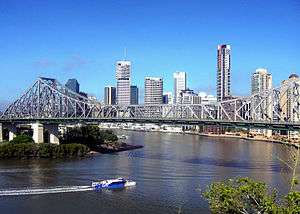

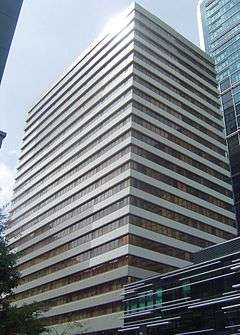
The Government of Queensland created the City of Brisbane with a view to uniting the then Brisbane metropolitan area under a single planning and governance structure. The City of Brisbane Act 1924 received assent from the Governor on 30 October 1924. On 1 October 1925, 20 local government areas of various sizes were abolished and merged into the new city,[7] namely:
- Cities:
- Towns:
- Shires:
The Council also assumed responsibility for several quasi-autonomous government authorities, such as the Brisbane Tramways Trust.
Governance
The City of Brisbane is governed by the Brisbane City Council, the largest local council in Australia. The Brisbane City Council has its power divided between a Lord Mayor, a parliamentary-style council of twenty-six councillors representing single-member wards of approximately 23,000 voters (roughly equivalent in size to state electorates), and a Civic Cabinet comprising the Lord Mayor, the Deputy Mayor (drawn from the majority on Council) and the chairpersons of the seven standing committees drawn from the membership of Council. Due to the City of Brisbane's status as the country's largest LGA, the Lord Mayor is elected by the largest single-member electorate in Australia. Like all mayors in Queensland, he has very broad executive power.
The seven standing committees of Council are:
- Community Services Committee
- Environment and Sustainability Committee
- Finance Committee
- Public Transport Committee
- Roads, TransApex and Traffic Committee
- Urban Planning and Economic Development Committee
- Water and City Businesses Committee
The council also owns three business units which are city-owned enterprises managed on commercial lines:
- Brisbane CityWorks
- Brisbane Transport
- Brisbane Water
Following local government elections on 28 April 2012, the Lord Mayor and 18 councillors are members of the Liberal National Party while 7 are from the Australian Labor Party with 1 independent. The current Lord Mayor of Brisbane is Graham Quirk of the LNP, who was elected mayor in his own right on 28 April 2012 after having been appointed to the Lord Mayoralty in April 2011 when Campbell Newman resigned to make an ultimately successful bid to become Premier of Queensland. The current Deputy Mayor is Adrian Schrinner of the LNP. The day-to-day management of Council's operations is the responsibility of the chief executive officer who is currently Colin Jensen.
Elections are held every four years with ballots for the Lord Mayoralty and the individual councillors being held simultaneously. Voting is compulsory for all eligible electors. The election in March 2004 resulted in the unusual situation of Liberal (later LNP after a July 2008 merger) Lord Mayor Campbell Newman co-existing with a Labor majority on Council and a Labor Deputy Mayor, though this resulted in remarkably few conflicts over civic budgets and Council policy. The LNP gained a 5.5% swing on the councillor votes in the March 2008 election, resulting in the Liberals taking control of the council as well (Newman won re-election with 60% of the primary vote). Graham Quirk won re-election as Lord Mayor (having been appointed to the position in April 2011) in 2012 with 61.94% of the vote and the LNP gained an additional 3 wards. The last election was held on 19 March 2016. Lord Mayor Graham Quirk defeated Labor's candidate Rod Harding.[8]
The Brisbane City Council is incorporated under the City of Brisbane Act 1924, while other local governments in Queensland are governed by the Local Government Act 1993.
Council meetings are held at Level 2, City Hall, 64 Adelaide Street, Brisbane City[9] every Tuesday at 2pm except during recess and holiday periods. This temporary venue is in use due to the restoration work being performed on the traditional venue Brisbane City Hall.[10] Meetings are generally open to the public.
Brisbane City Council aims to be carbon neutral by 2026 via the reduction of emissions and carbon offsetting.[11]
Heraldry
The motto of the City of Brisbane is Meliora sequimur, Latin for We aim for better things. The Council's corporate slogan is Dedicated to a better Brisbane. The City's colours are blue and gold. Its corporate logo was introduced in 1982 in preparation for the Commonwealth Games hosted in Brisbane that year. It features a stylised version of Brisbane's City Hall which opened in 1930. The City's floral emblem is the (exotic) poinsettia and its faunal emblem is the graceful tree frog.
Sister cities
The City of Brisbane has many valuable sister cities. They are:[12][13]
| City | Region | Country | Commenced | Finished |
|---|---|---|---|---|
| Nice | Alpes-Maritimes | France | 1995 | |
| Kobe[14] | Hyōgo Prefecture | Japan | July 1985 | |
| Auckland | Auckland Region | New Zealand | August 1988 | |
| Shenzhen[15][16][17] | Guangdong | China | June 1992 | |
| Semarang | Central Java | Indonesia | January 1993 | |
| Bangkok | Central Thailand | Thailand | May 1997 | Before March 2016 |
| Kaohsiung | Southern Taiwan | Taiwan | September 1997 | |
| Daejeon | Chungcheongnam-do | South Korea | June 2002 | |
| Chongqing | Chongqing1 | China | October 2005 | |
| Abu Dhabi | United Arab Emirates | February 2009 | ||
| Hyderabad[18] | Andhra Pradesh | India | October 2010 |
^1 Direct-controlled municipality of the People's Republic of China
In 1995, Brisbane City Council officially severed all ties with its sister city, Nice, France, in protest against the Chirac government's decision to resume nuclear testing in the Pacific Ocean.[19] Brisbane does not have any sister city relationship with any North American, South American, African or European city.[20]
See also
References
- ↑ "3218.0 – Regional Population Growth, Australia, 2014–15". Australian Bureau of Statistics. Retrieved 29 September 2016.
- ↑ "Table 1: Population growth and turnover in Local Government Areas (LGAs), 2006 to 2011". Australian Bureau of Statistics. Retrieved 10 August 2015.
- ↑ Hiroaki Suzuki; Arish Dastur; Sebastian Moffatt; Nanae Yabuki; Hinako Maruyama (2010). Eco2 Cities: Ecological Cities as Economic Cities. World Bank. p. 213. ISBN 978-0-8213-8046-8. Retrieved 12 March 2011.
- ↑ Council budget 2010–2011
- ↑ "2016 Brisbane City Council - Councillor Election - Election Summary". Electoral Commission of Queensland. 19 April 2016. Retrieved 10 June 2016.
- ↑ "The Gap Ward". Brisbane City Council. Retrieved 15 March 2016.
- ↑ City of Brisbane Act 1924 (accessed 23 January 2011)
- ↑ "Battle for Brisbane's City Hall takes shape". Brisbane Times. Retrieved 2016-01-01.
- ↑ "Meeting dates & locations". Brisbane City Council. Retrieved 21 March 2010.
- ↑ "City Hall Restoration". Brisbane City Council. Retrieved 21 March 2010.
- ↑ "Council's energy aims". Brisbane City Council. Retrieved 27 September 2010.
- ↑ "Facts & Statistics". Our Brisbane. Archived from the original on 14 October 2007. Retrieved 2 January 2008.
- ↑ "List of Sister Cities". www.brisbane.qld.gov.au. Brisbane City Council. Archived from the original on 21 March 2016. Retrieved 21 March 2016.
- ↑ "Kobe's Sister Cities". Kobe Trade Information Office. Archived from the original on 21 April 2013. Retrieved 11 August 2013.
- ↑ 友好城市 (Friendly cities) Archived 19 July 2014 at the Wayback Machine., 市外办 (Foreign Affairs Office), 22 March 2008. (Translation by Google Translate.)
- ↑ 国际友好城市一览表 (International Friendship Cities List) Archived 13 November 2013 at the Wayback Machine., 20 January 2011. (Translation by Google Translate.)
- ↑ 友好交流 (Friendly exchanges) Archived 12 November 2014 at the Wayback Machine., 13 September 2011. (Translation by Google Translate.)
- ↑ Moore, Tony. "Brisbane signs new sister city deal". Brisbane Times. Retrieved 2016-03-21.
- ↑ Thomas, Nicholas (2004). Re-Orienting Australia-China Relations: 1972 to the Present. Australia: Ashgate Publishing, Ltd. p. 75. ISBN 0-7546-3245-8. Retrieved 12 January 2008.
- ↑ Sister Cities – Brisbane City Council
External links
- Official website
- Brisbane City Council's Organisational Structure
- "Brisbane and Greater Brisbane". Queensland Places. Centre for the Government of Queensland, University of Queensland.
- Google map of pre 1925 merger Brisbane Councils
